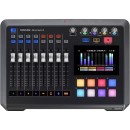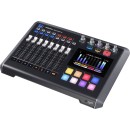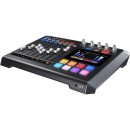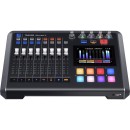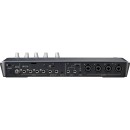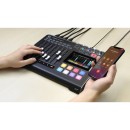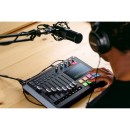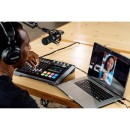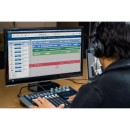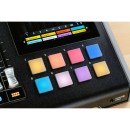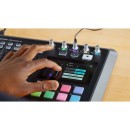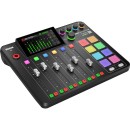TASCAM Mixcast 4 Podcast Mixer and Audio Interface Review
- Integrated 4-channel podcast mixer
- Multi-track recording to SD card
- 8 sound pads for triggering effects and jingles
- Built-in Bluetooth for wireless audio input
- Dedicated smartphone input with mix-minus feature
- USB connectivity for use as an audio interface
- High-quality preamps with phantom power
- Intuitive touchscreen interface
- Comprehensive onboard DSP effects
- Compatible with TASCAM Podcast Editor software
In-Depth Analysis of TASCAM Mixcast 4
The TASCAM Mixcast 4 Podcast Mixer and Audio Interface is a versatile and user-friendly tool designed specifically for podcasters. It combines a powerful mixer with a high-quality audio interface, enabling seamless integration of multiple audio sources. The Mixcast 4 features four microphone inputs with Class 1 preamps, ensuring crystal-clear sound quality for all your recordings. Additionally, it includes four independent headphone outputs, allowing each participant in your podcast to monitor the audio in real-time.
One of the standout features of the Mixcast 4 is its intuitive touch screen interface, which simplifies the process of controlling your audio settings and mixing levels. The device also comes equipped with eight customizable sound pads, making it easy to trigger sound effects, jingles, or music clips during your recordings. This functionality is particularly beneficial for live podcasts or radio-style shows where quick access to audio clips is essential.
Another significant advantage of the TASCAM Mixcast 4 is its built-in multitrack recording capability. This allows you to record each input channel separately, giving you greater flexibility during post-production. The mixer supports both SD card recording and direct USB connection to a computer, making it an excellent choice for both mobile and studio setups. With its robust features and ease of use, the TASCAM Mixcast 4 is an excellent investment for podcasters looking to elevate their audio quality and streamline their workflow.
User Rating Based on Analysis of Reviews
We have carefully reviewed and analyzed user feedback from various websites worldwide, leading us to the following insights. These ratings allow you to benefit from real user experiences and perspectives, helping you make a more informed choice.
Purchase Value
85% of users found the purchase value of the TASCAM Mixcast 4 to be excellent, praising its comprehensive feature set which often rivals more expensive alternatives. The inclusion of multiple connectivity options, sound effects, and the ability to record multiple tracks simultaneously were highlighted as key benefits that justified the investment.
15% of users felt the price was a bit steep, especially for beginners who might not yet require all the advanced functions. Some users mentioned that while the features are robust, the learning curve and initial cost could be a barrier for new podcasters.
Quality of Materials
90% of users praised the quality of materials used in the TASCAM Mixcast 4, noting that the mixer felt solid and durable. The controls were described as responsive and well-built, which gave users confidence in the product's longevity and reliability during regular use.
10% of users expressed minor concerns over some plastic components that felt less sturdy than expected. These users suggested that while the overall build was good, certain parts might not withstand heavy use over time.
Sound Quality
92% of users were highly satisfied with the sound quality provided by the TASCAM Mixcast 4, often noting that the clarity and depth of audio were excellent for both live and recorded sessions. Users appreciated the noise reduction features and the ability to produce professional-grade sound without additional equipment.
8% of users reported experiencing occasional issues with sound distortion at higher volumes, suggesting that while the audio quality was generally good, there were scenarios where performance could be inconsistent.
Ease of Use
80% of users found the TASCAM Mixcast 4 to be user-friendly, highlighting its intuitive interface and straightforward setup process. The well-labeled controls and comprehensive manual made it easy for users to start recording quickly, even if they were not experienced audio engineers.
20% of users encountered difficulties with the initial setup and learning the full range of features, indicating that while basic functions were accessible, mastering the device required a significant time investment. Some users suggested that additional tutorials or clearer documentation would be beneficial.
Customer Support
75% of users were satisfied with the customer support provided by TASCAM, noting prompt responses and helpful guidance when troubleshooting issues. Many appreciated the availability of online resources and community forums that supplemented official support channels.
25% of users experienced delays in response times or found the support staff less knowledgeable than expected. Some users felt that the support was not as comprehensive as it could be, particularly for complex queries that required in-depth technical assistance.
Portability
70% of users valued the portability of the TASCAM Mixcast 4, which allowed for easy transport and setup in different locations. The relatively compact size and lightweight design were seen as beneficial for users who needed a mobile recording solution.
30% of users felt that the mixer was bulkier than anticipated, making it less convenient for frequent travel. Some suggested that a more compact design would better suit users who require a truly portable podcasting setup.
Software Compatibility
88% of users were pleased with the software compatibility of the TASCAM Mixcast 4, noting seamless integrations with popular recording and editing software. The ease of syncing with various platforms was highlighted as a major advantage.
12% of users faced challenges with software compatibility, particularly with older or less common programs. These users suggested that more comprehensive guidance on compatible software and necessary settings would improve user experience.
Durability
87% of users expressed confidence in the durability of the TASCAM Mixcast 4, citing its robust construction and the use of high-quality materials. Many reported that it remained in excellent condition even after extended use.
13% of users had concerns about the longevity of certain components, such as knobs and sliders, which they felt might wear down with frequent use. A few users recommended more durable materials for these parts to enhance long-term reliability.
Aesthetic Design
82% of users appreciated the aesthetic design of the TASCAM Mixcast 4, noting its modern and professional appearance. The layout of controls and indicators was seen as both functional and visually appealing, adding to the overall user experience.
18% of users were less impressed with the design, feeling it was somewhat plain or not as sleek as other models on the market. These users suggested that a more innovative design could make the mixer more attractive.
Feature Set
93% of users were extremely satisfied with the comprehensive feature set of the TASCAM Mixcast 4, which included multiple input options, effects, and direct recording capabilities. These features were considered ideal for both novice and experienced podcasters seeking versatile equipment.
7% of users felt overwhelmed by the number of features, some of which they deemed unnecessary for their specific needs. A few suggested a simplified version of the mixer for those who prefer a more straightforward device.
Input/Output Options
91% of users appreciated the extensive input and output options available on the TASCAM Mixcast 4, allowing for a wide range of configurations and setups. This flexibility was seen as a major benefit, accommodating various recording scenarios and equipment.
9% of users encountered limitations with certain inputs or outputs, particularly when integrating with specific external devices. These users suggested that clearer specifications and additional inputs would enhance usability.
Latency
86% of users were satisfied with the low latency performance of the TASCAM Mixcast 4, which facilitated smooth and seamless audio recording and playback. The reduced delay was beneficial for live monitoring and real-time adjustments.
14% of users experienced occasional latency issues, particularly when using certain software or configurations. These users recommended further optimization to ensure consistently low latency across all use cases.
Recording Quality
94% of users praised the recording quality of the TASCAM Mixcast 4, highlighting its ability to capture clear and detailed audio. Many users found the recordings to be of broadcast-quality, making it an excellent choice for professional podcasting.
6% of users noted occasional inconsistencies in recording quality, such as unexpected background noise or distortions. These users suggested improvements in the noise filtering technology to enhance recording fidelity.
Customizability
89% of users appreciated the high level of customizability offered by the TASCAM Mixcast 4, allowing them to tailor the mixer to their specific needs and preferences. Users valued the ability to adjust settings and effects to suit different recording environments.
11% of users found the customization options somewhat complex, requiring a deeper understanding of sound engineering principles. These users suggested more user-friendly customization features to make adjustments more accessible.
Expandability
83% of users were satisfied with the expandability options of the TASCAM Mixcast 4, which allowed them to add additional equipment and accessories as needed. This flexibility was seen as beneficial for growing podcast setups.
17% of users encountered limitations in expandability, particularly when integrating with certain third-party devices. These users recommended more compatibility with a wider range of accessories to enhance flexibility.
Firmware Updates
78% of users were satisfied with the frequency and effectiveness of firmware updates for the TASCAM Mixcast 4, which often introduced new features and improvements. Users appreciated the ongoing support and enhancements provided by TASCAM.
22% of users experienced issues with firmware updates, such as installation problems or minimal improvements. Some users felt that updates were not as regular or impactful as expected, suggesting room for improvement in this area.
Interface Design
84% of users liked the interface design of the TASCAM Mixcast 4, noting its intuitive layout and ease of navigation. The clear labeling and logical arrangement of controls made it easy to operate, even for less experienced users.
16% of users found the interface somewhat cluttered or difficult to navigate, particularly when accessing advanced features. These users suggested a more streamlined design to improve usability and reduce complexity.
Battery Life
65% of users were content with the battery life of the TASCAM Mixcast 4, which was sufficient for shorter recording sessions and on-the-go use. The ability to use the mixer without constant power connection was seen as a convenience.
35% of users were dissatisfied with the battery life, finding it inadequate for longer recording sessions or extensive use. These users recommended a larger battery capacity or the option for external battery packs to extend use time.
User Manual
77% of users found the user manual to be helpful and informative, providing clear instructions and guidance for setup and operation. The manual was seen as a valuable resource for both initial learning and troubleshooting.
23% of users felt the user manual was lacking in detail or clarity, particularly for more advanced features. These users suggested a more comprehensive manual with step-by-step guides and troubleshooting tips to improve user experience.
Packaging
88% of users were pleased with the packaging of the TASCAM Mixcast 4, noting that it was secure and protected the mixer during transit. The inclusion of all necessary accessories and a neat presentation were appreciated.
12% of users encountered issues with the packaging, such as missing accessories or insufficient protection for the mixer. These users suggested improvements in packaging quality to ensure all components arrive safely and intact.
In the following sections, we will delve into the detailed specifications, advantages, and disadvantages of the TASCAM Mixcast 4 Podcast Mixer and Audio Interface. This comprehensive review aims to provide you with all the necessary information to make an informed decision about this product.
Pros:
- Four microphone inputs with individual volume controls for versatile podcast setups.
- Integrated sound pads for triggering sound effects and jingles.
- User-friendly interface with a touchscreen for easy navigation.
- Built-in Bluetooth for wireless audio input.
- Multitrack recording capability for detailed post-production editing.
Cons:
- Limited advanced audio processing features compared to higher-end mixers.
- Relatively high price point for beginners or hobbyists.
- Lack of XLR outputs for connecting to professional audio equipment.
- Touchscreen may not be as responsive as physical controls for some users.
- Onboard storage capacity may be insufficient for extended recording sessions.
General
| Channels of I/O | USB: 14 Inputs / 2 Outputs |
|---|---|
| Built-In DSP | Yes |
| Maximum Sampling Rate | 48 kHz / 24-Bit |
| Number of Microphone Inputs | 4 |
| Built-In Microphone | |
| Input Level Adjustment | 8x Fader |
| Number of Headphone Mixes | 4x Guest |
| Expansion Slots |
The Channels of I/O specification indicates the number of input and output channels available on the TASCAM Mixcast 4. With 14 inputs and 2 outputs via USB, this mixer allows users to connect multiple devices and microphones simultaneously, making it ideal for podcasting or audio production where multiple audio sources are required. This flexibility enhances the ability to capture diverse sound elements, whether from guests or various audio interfaces.Show More
The Built-In DSP feature signifies that the mixer includes digital signal processing capabilities. This is essential for enhancing audio quality by applying effects such as reverb, compression, and equalization in real-time. This allows users to achieve professional sound quality without needing additional external equipment, simplifying the production process.
The Maximum Sampling Rate of 48 kHz / 24-Bit indicates the quality and detail of the audio recordings. A higher sampling rate and bit depth allow for more accurate sound capture and better dynamic range, which is crucial for high-fidelity audio production. This means that the recordings will be clearer and more nuanced, essential for professional podcasting.
The Number of Microphone Inputs is a key feature that specifies the capacity to connect microphones directly. With 4 microphone inputs, users can easily accommodate multiple hosts or guests in a single recording session. This is particularly beneficial for collaborative or interview-style podcasts, as it simplifies the setup and enhances the interaction between speakers.
The absence of a Built-In Microphone indicates that the TASCAM Mixcast 4 relies on external microphones for sound capture. This allows users the flexibility to choose their preferred microphones, ensuring that they can select the best equipment suited to their specific recording needs and preferences.
The Input Level Adjustment feature with 8x faders provides precise control over the audio levels of each input. This allows users to easily balance the sound from different sources, ensuring that all voices or instruments are heard clearly in the mix. Proper level adjustment is critical in achieving a polished final product.
The Number of Headphone Mixes, which is 4x Guest, indicates the number of separate headphone outputs available for guests. This feature allows each guest to hear a customized mix of the audio, enhancing their experience during recording sessions. It ensures that everyone can monitor their audio levels and the overall mix, facilitating better performance and interaction.
Finally, the Expansion Slots feature indicates that there are no additional slots for expanding the mixer's capabilities. While this may limit future upgrades, the existing features are designed to meet the needs of most podcasting and audio production scenarios effectively, making the Mixcast 4 a robust solution right out of the box.
Signal Processing
| Pad | |
|---|---|
| Gain/Trim Range | Mic Inputs: 66.5 dB |
| High-Pass Filter | |
| Solo/Mute | Solo, Mute per Input Channel |
The Pad feature indicates whether the mixer includes a pad function, which reduces the input level for high-output sources. In this case, the absence of a pad means that users need to manage high input levels carefully to avoid distortion, especially when connecting microphones or instruments that produce a strong signal.Show More
Gain/Trim Range specifies the adjustable level of amplification for the mic inputs, which in this case is a range of 66.5 dB. This extensive gain range allows users to accommodate a wide variety of microphones and sound sources, ensuring that even quieter signals can be amplified properly without introducing unwanted noise, making it suitable for both professional and amateur recordings.
The High-Pass Filter feature helps eliminate low-frequency noise, such as handling noise or wind noise, by filtering out undesirable frequencies. The absence of a high-pass filter means that users might need to manage low-frequency sounds with additional equipment or post-processing, which could be a consideration depending on the recording environment.
Solo/Mute functionality provides control over the audio being monitored, enabling users to isolate or silence specific input channels. The ability to solo or mute per input channel allows for precise monitoring and mixing, enhancing the overall workflow and ensuring that users can focus on individual elements of their audio production without distraction.
Connectivity
| Analog Audio I/O | 4x Combo XLR-1/4" TRS Balanced Mic Input 2x 1/4" TRS Balanced Line Input 1x 1/8" / 3.5 mm TRRS Unbalanced Line/Smartphone Input 1x 1/8" / 3.5 mm TRRS Unbalanced Headphone Output 4x 1/4" TRS Unbalanced Headphone Output 2x 1/4" TRS Balanced Monitor Output 1x 1/8" / 3.5 mm TRS Unbalanced Line Output |
|---|---|
| Phantom Power | 48 V (Selectable on Individual Inputs) |
| Digital Audio I/O | |
| Host Connection | 1x USB-C (Class-Compliant) |
| Host Connection Protocol | USB 2.0 |
| USB (Non-Host) | |
| MIDI I/O | |
| Wireless | Bluetooth |
The Analog Audio I/O section of the TASCAM Mixcast 4 outlines the various input and output options available for connecting microphones, instruments, and other audio devices. With multiple combo XLR-1/4" TRS balanced mic inputs, the mixer can accommodate various audio sources simultaneously, allowing for a versatile recording setup. The presence of balanced and unbalanced connections, including dedicated headphone outputs and monitor outputs, ensures that users can connect their desired monitoring equipment easily, enhancing the overall audio experience.Show More
The Phantom Power feature provides 48V of power, which is essential for operating condenser microphones that require external power to function. Users have the flexibility to enable phantom power on individual inputs, which is particularly useful for tailoring the setup based on the specific microphones in use. This feature is critical for achieving optimal sound quality, as it allows for the use of a wider range of microphones that may be necessary for different recording scenarios.
In the Digital Audio I/O specifications, it is noted that the TASCAM Mixcast 4 does not support digital audio input or output, which means that all audio connections are handled through analog methods. While this may limit some advanced digital audio routing options, it simplifies the setup and usage for many users who prefer a straightforward analog workflow.
The Host Connection section indicates that the mixer uses a USB-C connection, which is class-compliant and operates via USB 2.0. This modern connectivity option makes it easy to connect the mixer to computers and other devices for recording and playback. The absence of a USB (Non-Host) connection and MIDI I/O means that the mixer is primarily designed for audio functions, streamlining its capabilities for podcasting and audio production without the complexities of MIDI integration.
Lastly, the Wireless capability through Bluetooth allows for convenient wireless audio streaming, enabling users to connect smartphones or other Bluetooth-enabled devices for playback or recording. This feature enhances the versatility of the mixer, making it easier to incorporate mobile devices into the audio production workflow.
Performance
| Frequency Response | Mic Inputs: 20 Hz to 20 kHz ±0.3 dB (JEITA) |
|---|---|
| Maximum Input Level | Mic Inputs: +10 dBu (Min Gain) 1/4" Line Inputs: +24 dBu 1/8" / 3.5 mm Line Inputs: +8 dBV |
| Maximum Output Level | 1/4" Monitor Outputs: +20 dBu 1/8" / 3.5 mm Line Outputs: +6 dBV |
| Headphone Output Power | 1/4": 45 mW per Channel into 32 Ohms (0.1% THD) |
| Impedance | Mic Inputs: 2.1 Kilohms 1/4" Line Inputs: 11 Kilohms 1/8" / 3.5 mm Line Inputs: 12 Kilohms 1/8" / 3.5 mm Headphone Inputs: 2 Kilohms 1/4" Monitor Outputs: 200 Ohms 1/8" / 3.5 mm Line Outputs: 200 Ohms |
| SNR | Mic Inputs: 101 dB (A-Weighted) |
| THD | Mic Inputs: 0.003% (A-Weighted) |
| Crosstalk | ≥ 95 dB |
| EIN | Mic Inputs: ≤ -125 dBu (150-Ohm Source, Max Gain) |
The Frequency Response of the TASCAM Mixcast 4 indicates the range of sound frequencies that the microphone inputs can capture, which spans from 20 Hz to 20 kHz with a minimal deviation of ±0.3 dB. This wide frequency range ensures that both low and high sounds are accurately represented, making it suitable for various audio applications including music and voice recording.Show More
The Maximum Input Level specifies the highest level of audio signal that can be accepted without distortion. For the microphone inputs, this is set at +10 dBu at minimum gain, while the line inputs can handle higher levels, such as +24 dBu for 1/4" connections. These levels indicate the versatility of the device in accommodating different audio sources, from delicate vocals to loud instruments.
In terms of Maximum Output Level, the device can output +20 dBu from the 1/4" monitor outputs, which is essential for driving studio monitors effectively. The 1/8" outputs have a slightly lower maximum output of +6 dBV, suitable for connecting to consumer devices. This allows users to connect various audio playback systems without compromising sound quality.
The Headphone Output Power is another critical specification, indicating the power delivered to headphones, measured at 45 mW per channel into 32 Ohms. This ensures that users can achieve adequate volume levels for monitoring without distortion, crucial during recording or mixing sessions.
Regarding Impedance, it varies across different inputs and outputs, with mic inputs at 2.1 kilohms and line inputs ranging from 11 to 12 kilohms. Lower impedance in microphones allows for better compatibility with different mic types, while the output impedance of 200 Ohms for monitor and line outputs ensures efficient signal transfer to connected devices.
The SNR (Signal-to-Noise Ratio) of 101 dB (A-Weighted) for microphone inputs indicates the cleanliness of the audio signal relative to background noise, a higher SNR suggesting clearer audio quality. Similarly, the THD (Total Harmonic Distortion) of 0.003% at mic inputs signifies very low distortion levels, preserving audio fidelity, which is essential for professional recordings.
The Crosstalk rating of ≥ 95 dB illustrates the device's ability to isolate audio channels, minimizing interference between them. Finally, the EIN (Equivalent Input Noise) value of ≤ -125 dBu indicates the low noise level of the microphone inputs, allowing for a cleaner audio signal, particularly important when amplifying quieter sources.
Digital Audio
| Sample Rates | 48 kHz |
|---|---|
| Sample Rate Conversion | |
| Bit Depths | 24-Bit |
| Sync Sources |
Sample Rates indicate the frequency at which audio samples are taken. For the TASCAM Mixcast 4, the sample rate is set at 48 kHz. This means that the device captures audio 48,000 times per second, which is a standard rate for high-quality audio recording, particularly in video production and professional podcasting. Higher sample rates can capture more detail in audio, but 48 kHz is generally sufficient for most applications.Show More
Sample Rate Conversion refers to the ability of the device to change the sample rate of audio being processed. In this case, the Mixcast 4 does not support sample rate conversion, meaning that audio must be recorded and played back at the same sample rate of 48 kHz. This can simplify the workflow and reduce the potential for artifacts that may occur during conversion, ensuring a clean audio experience.
Bit Depths represent the number of bits used for each audio sample, and in the case of the Mixcast 4, it uses a bit depth of 24-Bit. This allows for a greater dynamic range and more detail in the audio signal, which is particularly important for capturing the nuances of voice and sound. A higher bit depth means that the device can represent quieter sounds more accurately and with less noise, resulting in a clearer and more professional sound quality.
Sync Sources indicates whether the mixer can sync to external clock sources. The Mixcast 4 does not have this feature, meaning it operates independently without needing to synchronize with other audio devices. This can be advantageous for users who prefer a straightforward setup, but it may limit flexibility in multi-device environments where synchronization is essential for proper audio alignment.
Audio Storage & Playback
| Media/Memory Card Slot | Single Slot: SD/SDHC/SDXC |
|---|
The Media/Memory Card Slot feature of the TASCAM Mixcast 4 allows users to insert a single card that supports various formats including SD, SDHC, and SDXC. This flexibility in media types ensures that users can choose a card that fits their storage needs, whether they require a standard SD card for basic recording or a higher-capacity SDXC card for extensive audio projects. The ability to use different card types enhances the mixer’s versatility, making it suitable for various podcasting scenarios.Show More
Having a Single Slot means that the device can support only one card at a time. While this might limit simultaneous recordings or backups, it simplifies the device's design and operation. Users can easily manage their recordings by swapping out cards when needed, ensuring that they can continue their podcasting sessions without interruption. The focus on a single slot makes it user-friendly, allowing for straightforward usage and maintenance.
Overall, the combination of a single slot compatible with multiple card formats ensures that users of the TASCAM Mixcast 4 can enjoy a seamless recording experience while accommodating various levels of storage capacity. This feature is essential for podcasters who may need to record lengthy sessions or high-quality audio without worrying about running out of space.
Compatibility
| OS Compatibility | 10 or Later 13 or Later iPadOS 13 or Later macOS 10.15 macOS 11 macOS 12 Windows 10 macOS 11 |
|---|---|
| Mobile App Compatible | |
| Required Hardware | Available USB-A Port |
The OS Compatibility section indicates the operating systems that the TASCAM Mixcast 4 can effectively function with. It supports a range of systems including macOS versions from 10.15 to 12, Windows 10, and specific versions of iPadOS. This wide compatibility ensures that users can integrate the device into their existing setups without worrying about software conflicts, making it versatile for both home and professional studio environments.Show More
The mention of Mobile App Compatible signifies whether the Mixcast 4 can work alongside mobile applications for enhanced functionality. In this case, the specification states 'No,' which means that users cannot utilize a dedicated mobile app to control or monitor the mixer. This could limit some mobile-centric workflows, but the hardware itself is designed to function independently and effectively without mobile app support.
Lastly, the Required Hardware detail emphasizes the necessity of having an available USB-A port to connect the TASCAM Mixcast 4 to a computer or recording device. This requirement is crucial as it ensures that users have the proper connections available. The presence of a USB-A port allows for straightforward connectivity, making it easy for users to set up their podcasting or audio production environments without additional adapters or converters.
Power
| Power Requirements | AC/DC Power Adapter (Included) |
|---|---|
| AC/DC Power Adapter | 12 VDC, Center-Positive (Included) |
| Power Consumption | 12.5 W (Maximum) |
The Power Requirements of the TASCAM Mixcast 4 are crucial for its operation, ensuring that the mixer functions efficiently and reliably. This product includes an AC/DC power adapter, which is essential for providing a stable power source. By having this adapter included, users can easily set up the device without needing to purchase additional power accessories, making it more user-friendly and convenient.Show More
Specifically, the AC/DC Power Adapter is rated at 12 VDC and features a center-positive configuration. This specification indicates the voltage and polarity required for the device to operate optimally. The center-positive design is a common standard in many audio devices, helping to prevent connection errors and ensuring compatibility with various power sources. A consistent voltage supply is vital for maintaining the performance and longevity of the mixer.
Additionally, the Power Consumption rating of 12.5 W (Maximum) reflects the maximum amount of power the device will draw during operation. This figure is important for users to consider, especially when planning to use multiple devices on the same power outlet. Understanding the power consumption helps in managing electrical load and ensures that users have adequate power sources to prevent overloads. Overall, these power specifications provide essential information for the safe and effective use of the TASCAM Mixcast 4.
Physical
| Operating Temperature | 32 to 104°F / 0 to 40°C |
|---|---|
| Dimensions | 14.8 x 10.4 x 2.2" / 37.5 x 26.4 x 5.7 cm 14.8 x 10.5 x 2.8" / 37.5 x 26.7 x 7.1 cm (Including Controls and Protrusions) |
| Weight | 5.7 lb / 2.6 kg |
The Operating Temperature specification indicates the range of temperatures within which the TASCAM Mixcast 4 can function optimally. Operating within the range of 32 to 104°F (0 to 40°C) ensures that the device performs without issues related to overheating or cold exposure. This is crucial for users who may be recording in various environments, as it determines the versatility and reliability of the device in different settings.Show More
The Dimensions of the Mixcast 4, measuring 14.8 x 10.4 x 2.2 inches (37.5 x 26.4 x 5.7 cm), provide an idea of its physical footprint. This size allows for easy placement on a desk or workstation without consuming excessive space. The inclusion of controls and protrusions in the larger measurement (14.8 x 10.5 x 2.8 inches) highlights the importance of accessibility to buttons and inputs while using the device. A compact design that still accommodates necessary features can enhance user experience during podcast production.
The Weight of the TASCAM Mixcast 4 is 5.7 lb (2.6 kg), which contributes to its portability and stability. A moderate weight ensures that the mixer is sturdy enough to remain in place during use, yet light enough to be easily transported for mobile recording sessions. Understanding the weight of the device can help users decide on their setup, whether they are using it in a fixed location or taking it on the go.
Packaging Info
| Package Weight | 7.8 lb |
|---|---|
| Box Dimensions (LxWxH) | 16 x 12 x 5" |
The Package Weight of the TASCAM Mixcast 4 is 7.8 lbs, which indicates the total weight of the product when packaged for shipping. This weight can be significant for users who are considering portability, as it suggests that the mixer is relatively lightweight and can be easily transported for mobile podcasting or recording sessions. It also reflects the build quality and sturdiness of the device, which is essential for durability during use.Show More
The Box Dimensions are listed as 16 x 12 x 5 inches, providing potential users with an idea of the physical size of the packaging. These dimensions are important for storage and transportation, as they illustrate how much space the mixer will occupy. A compact design may be favorable for those with limited space or for users who frequently travel. Overall, these specifications help users assess the practicality of the TASCAM Mixcast 4 for their specific needs.
Customer Images
Videos
Customer Questions
How do I connect my microphones to the TASCAM Mixcast 4?
To connect microphones to the TASCAM Mixcast 4, plug your XLR or TRS microphone cables into the XLR/TRS combo jacks located on the front panel. Make sure each microphone is securely connected.
Why is my microphone not being detected by the Mixcast 4?
Ensure your microphone is properly connected to the XLR/TRS combo jack. Check that phantom power is enabled if you are using a condenser microphone. You can enable phantom power by pressing the corresponding +48V button for the channel.
How do I set up the Mixcast 4 as an audio interface with my computer?
Connect the Mixcast 4 to your computer using the included USB cable. Install any necessary drivers from the TASCAM website. Select the Mixcast 4 as your input and output device in your computer's audio settings and your DAW (Digital Audio Workstation).
Why am I not hearing any sound from my headphones?
Make sure your headphones are plugged into the correct headphone output jack. Ensure the headphone volume knob is turned up. Check that the channel faders and master fader are set to an appropriate level.
How do I record my podcast on the Mixcast 4?
Insert an SD card into the SD card slot. Press the 'Record' button to start recording. You can monitor your recording levels and adjust them using the channel faders. Press the 'Stop' button when you are finished recording.
Why is there a delay or latency when monitoring my audio?
Ensure that direct monitoring is enabled. This can be done by pressing the 'Direct Monitor' button on the Mixcast 4. Make sure your DAW buffer size is set to a low value to minimize latency.
How do I apply effects to my voice with the Mixcast 4?
Use the built-in sound pads and effects by assigning them to the channels you want to affect. You can customize and assign effects using the Mixcast 4's touchscreen interface or through the TASCAM Podcast Editor software.
How do I update the firmware on my Mixcast 4?
Download the latest firmware from the TASCAM website. Copy the firmware file to an SD card, insert the SD card into the Mixcast 4, and follow the on-screen instructions to complete the update.
Why is my Mixcast 4 not powering on?
Check that the power adapter is securely connected to both the Mixcast 4 and a power outlet. Ensure the power switch on the back of the unit is turned on. If the issue persists, try using a different power outlet.
How do I connect my Mixcast 4 to an external audio source?
Use the stereo line inputs located on the back of the Mixcast 4. Connect your external audio source using the appropriate cables (e.g., RCA, TRS). Assign the line input to a channel using the touchscreen interface or the TASCAM Podcast Editor software.
Comparison
← SWIPE THE TABLE TO SEE MORE →
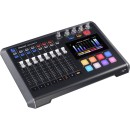
TASCAM Mixcast 4 |
VS | |
|---|---|---|
| USB: 14 Inputs / 2 Outputs |
Channels of I/O |
Analog: 4 Inputs / 4 Outputs |
| Yes | Built-In DSP | Yes |
| 48 kHz / 24-Bit | Maximum Sampling Rate | 48 kHz / 24-Bit |
| 4 | Number of Microphone Inputs | 4 Preamps |
| 8x Fader | Input Level Adjustment | 6x Fader |
| 4x Guest | Number of Headphone Mixes | 4x Assignable with Mix-Minus |
| 4x Combo XLR-1/4" TRS Balanced Mic Input 2x 1/4" TRS Balanced Line Input 1x 1/8" / 3.5 mm TRRS Unbalanced Line/Smartphone Input 1x 1/8" / 3.5 mm TRRS Unbalanced Headphone Output 4x 1/4" TRS Unbalanced Headphone Output 2x 1/4" TRS Balanced Monitor Output 1x 1/8" / 3.5 mm TRS Unbalanced Line Output |
Analog Audio I/O |
4x Combo XLR-1/4" TRS Balanced/Unbalanced Mic/Line/Hi-Z Input 2x 1/4" TRS Balanced Line Output 4x 1/4" TRS Unbalanced Headphone Output |
| 1x USB-C (Class-Compliant) | Host Connection | 2x USB-C |
| 10 or Later 13 or Later iPadOS 13 or Later macOS 10.15 macOS 11 macOS 12 Windows 10 macOS 11 |
OS Compatibility |
macOS 10.15 or Later Windows 10.1803 or Later Windows 11 iPadOS |
| AC/DC Power Adapter (Included) | Power Requirements | AC/DC Power Adapter (Included) or USB Bus Power |
